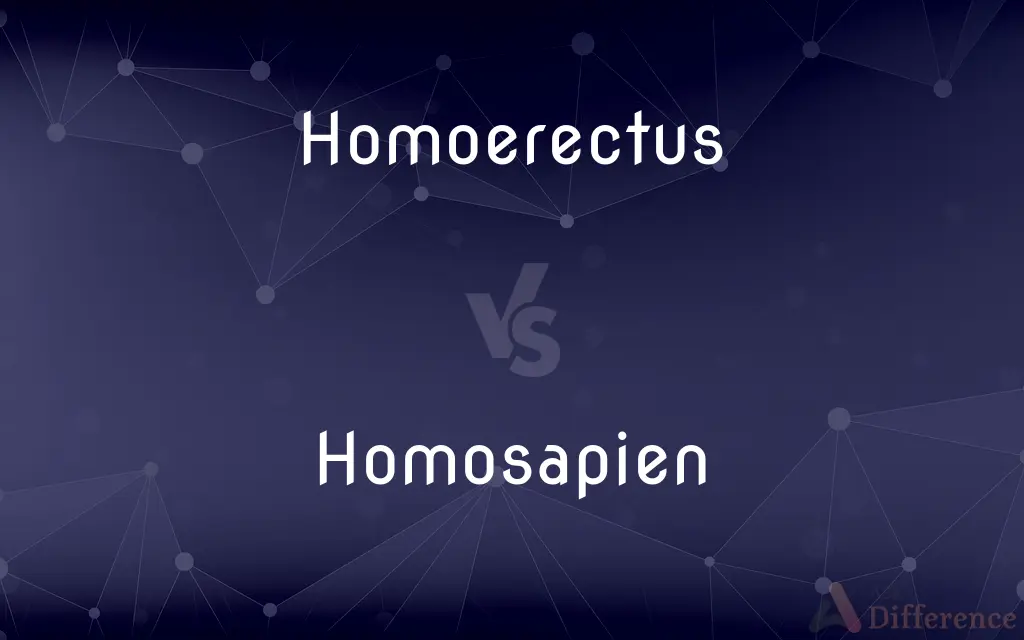Homoerectus vs. Homosapien — What's the Difference?
By Maham Liaqat & Fiza Rafique — Published on February 24, 2024
Homo erectus was human species living 1.9 million to 110,000 years ago, known for upright walking and tool use, while Homo sapiens, emerged around 300,000 years ago, distinguished by complex language, sophisticated tools, and advanced social structures.

Difference Between Homoerectus and Homosapien
Table of Contents
ADVERTISEMENT
Key Differences
Homo erectus and Homo sapiens represent two distinct points in the evolutionary timeline of humans, each with unique characteristics and contributions to human evolution. Homo erectus, emerging around 1.9 million years ago, is recognized for being one of the first hominins to exhibit full bipedal locomotion and for their use of basic stone tools. This species spread across Africa and into Asia, demonstrating a significant ability to adapt to diverse environments.
Homo sapiens, on the other hand, marks the arrival of a species with a capacity for symbolic thought, complex language, and the creation of advanced tools and art. Modern humans have a larger brain size, which supports our complex cognitive abilities and social interactions. The emergence of Homo sapiens around 300,000 years ago signaled the development of more sophisticated cultural and technological innovations, including agriculture, cities, and civilizations. Unlike Homo erectus, Homo sapiens have a global distribution, having migrated to nearly every continent and environment on Earth.
Homo erectus relied on simple stone tools for hundreds of thousands of years, while Homo sapiens developed a wide array of tool technologies and art, such as painting, sculpture, and music. This cultural complexity reflects the advanced cognitive abilities of Homo sapiens, including abstract thinking, planning, and cooperation.
The transition from Homo erectus to Homo sapiens also illustrates significant changes in social structures. Homo erectus likely lived in small groups with relatively simple social dynamics, while Homo sapiens developed complex social hierarchies, trade networks, and diverse forms of governance.
Ultimately, the evolutionary journey from Homo erectus to Homo sapiens highlights the significant developments in brain size, tool use, cultural complexity, and social organization that have defined the human species. These changes not only reflect the biological evolution of humans but also the cultural and technological advancements that have allowed Homo sapiens to become the dominant species on the planet.
ADVERTISEMENT
Comparison Chart
Time Period
1.9 million to 110,000 years ago
Around 300,000 years ago to present
Brain Size
600-1,100 cubic centimeters
1,200-1,600 cubic centimeters
Tool Use
Basic stone tools
Sophisticated tools, art, and technology
Social Structures
Simple group dynamics
Complex social hierarchies, trade, civilizations
Language and Culture
Limited evidence of symbolic communication
Complex language, symbolic thought, art
Global Distribution
Africa, parts of Asia, and Europe
Global, every continent except Antarctica
Compare with Definitions
Homoerectus
Used fire and simple shelters for survival.
Evidence suggests Homo erectus was among the first to control fire.
Homosapien
Characterized by a significant capacity for innovation and creativity.
The creation of art and music is unique to Homo sapiens.
Homoerectus
Exhibited significant physical endurance and adaptability.
Homo erectus is believed to have been capable of long-distance treks.
Homosapien
Possess a global presence, adapting to diverse environments.
Homo sapiens inhabit environments ranging from Arctic cold to desert heat.
Homoerectus
An early human species known for upright walking and basic tool use.
Homo erectus crafted hand axes from stone for hunting.
Homosapien
Developed agriculture, leading to the rise of civilizations.
Homo sapiens transitioned from hunter-gatherers to agricultural societies.
Homoerectus
Lived in Africa and Asia, showing adaptability to various environments.
The spread of Homo erectus into Asia signifies one of the first major human migrations.
Homosapien
Continue to evolve, both biologically and culturally.
The rapid technological advancements of Homo sapiens mark ongoing evolution.
Homoerectus
Represents a key ancestor of modern humans.
The evolutionary advancements of Homo erectus laid the groundwork for later human species.
Homosapien
Modern humans with advanced cognitive skills and complex culture.
Homo sapiens developed languages, enabling sophisticated communication.
Common Curiosities
What distinguishes the tools used by Homo erectus from those of Homo sapiens?
Homo erectus tools were relatively simple and changed little over time, while Homo sapiens developed a diverse range of sophisticated tools and technologies.
How did the social structures of Homo erectus and Homo sapiens differ?
Homo erectus likely had simpler social structures, while Homo sapiens developed complex societies with intricate social, political, and economic systems.
What role did language play in the development of Homo sapiens?
Language facilitated complex communication, collaboration, and the transmission of knowledge, significantly contributing to the success and cultural development of Homo sapiens.
What are the current challenges facing Homo sapiens?
Challenges include environmental degradation, climate change, and managing technological and social changes that impact global health and sustainability.
Did Homo erectus and Homo sapiens coexist?
There is overlap in their timelines, suggesting a possibility of coexistence, but direct interaction is not well-documented.
Can Homo erectus be considered the first true human?
While not modern humans, Homo erectus is recognized as a significant early human species due to their advancements in tool use and migration.
How did Homo erectus contribute to the evolution of Homo sapiens?
Homo erectus laid the foundations for tool use, migration patterns, and adaptations that were crucial in the evolution of Homo sapiens.
Why is Homo sapiens the only surviving human species?
Homo sapiens' superior cognitive abilities, adaptability, and technological advancements likely contributed to their survival and dominance over other hominin species.
What is the most significant difference between Homo erectus and Homo sapiens?
The most significant difference lies in their cognitive abilities and cultural complexity, with Homo sapiens exhibiting advanced language, art, and technology.
How have Homo sapiens impacted the planet?
Through agriculture, urbanization, and technological advancements, Homo sapiens have dramatically altered the Earth's landscapes and ecosystems.
Share Your Discovery

Previous Comparison
Fuel vs. Gas
Next Comparison
Curriculum vs. Scheme of WorkAuthor Spotlight
Written by
Maham LiaqatCo-written by
Fiza RafiqueFiza Rafique is a skilled content writer at AskDifference.com, where she meticulously refines and enhances written pieces. Drawing from her vast editorial expertise, Fiza ensures clarity, accuracy, and precision in every article. Passionate about language, she continually seeks to elevate the quality of content for readers worldwide.














































